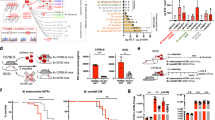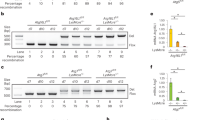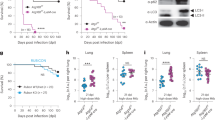Abstract
Mycobacterium tuberculosis claims more human lives each year than any other bacterial pathogen. Infection is maintained in spite of acquired immunity and resists eradication by antimicrobials1,2. Despite an urgent need for new therapies targeting persistent bacteria, our knowledge of bacterial metabolism throughout the course of infection remains rudimentary. Here we report that persistence of M. tuberculosis in mice is facilitated by isocitrate lyase (ICL), an enzyme essential for the metabolism of fatty acids3,4. Disruption of the icl gene attenuated bacterial persistence and virulence in immune-competent mice without affecting bacterial growth during the acute phase of infection. A link between the requirement for ICL and the immune status of the host was established by the restored virulence of Δicl bacteria in interferon-γ knockout mice. This link was apparent at the level of the infected macrophage: Activation of infected macrophages increased expression of ICL, and the Δicl mutant was markedly attenuated for survival in activated but not resting macrophages. These data suggest that the metabolism of M. tuberculosis in vivo is profoundly influenced by the host response to infection, an observation with important implications for the treatment of chronic tuberculosis.
This is a preview of subscription content, access via your institution
Access options
Subscribe to this journal
Receive 51 print issues and online access
$199.00 per year
only $3.90 per issue
Buy this article
- Purchase on Springer Link
- Instant access to full article PDF
Prices may be subject to local taxes which are calculated during checkout





Similar content being viewed by others
References
McKinney, J. D., Jacobs, W. R. & Bloom, B. R. in Emerging Infections (eds Krause, R., Gallin, J. I. & Fauci, A. S.) 51–146 (Academic, New York, 1998).
Parrish, N. M., Dick, J. D. & Bishai, W. R. Mechanisms of latency in Mycobacterium tuberculosis . Trends Microbiol. 6, 107– 112 (1998).
Clark, D. P. & Cronan, J. E. Jr in Escherichia coli and Salmonella: Cellular and Molecular Biology (ed. Neidhardt, F. C.) 343–357 (ASM Press, Washington DC, 1996).
Cronan, J. E. Jr. & LaPorte, D. in Escherichia coli and Salmonella: Cellular and Molecular Biology (ed. Neidhardt, F. C.) 206–216 (ASM Press, Washington DC, 1996).
Segal, W. in The Mycobacteria: A Sourcebook (eds Kubica, G. P. & Wayne, L. G.) 547–573 (Dekker, New York, 1984 ).
Wheeler, P. R. & Ratledge, C. in Tuberculosis: Pathogenesis, Protection, and Control (ed. Bloom, B. R.) 353– 385 (ASM Press, Washington DC, 1994).
Höner zu Bentrup, K., Miczak, A., Swenson, D. L. & Russell, D. G. Characterization of activity and expression of isocitrate lyase in Mycobacterium avium and Mycobacterium tuberculosis. J. Bacteriol. 181, 7161–7167 ( 1999).
Sturgill-Koszycki, S., Haddix, P. L. & Russell, D. G. The interaction between Mycobacterium and the macrophage analyzed by two-dimensional polyacrylamide gel electrophoresis. Electrophoresis 18, 2558– 2565 (1997).
Graham, J. E. & Clark-Curtiss, J. E. Identification of Mycobacterium tuberculosis RNAs synthesized in response to phagocytosis by human macrophages by selective capture of transcribed sequences (SCOTS). Proc. Natl Acad. Sci. USA 96, 11554–11559 (1999).
Farewell, A., Diez, A. A., DiRusso, C. C. & Nystrom, T. Role of the Escherichia coli FadR regulator in stasis survival and growth phase-dependent expression of the uspA, fad, and fab genes. J. Bacteriol. 178, 6443–6450 (1996).
Spector, M. P. et al. The medium-/long-chain fatty acyl-CoA dehydrogenase (fadF) gene of Salmonella typhimurium is a phase 1 starvation-stress response (SSR) locus. Microbiol. 145, 15– 31 (1999).
Suryanarayana Murthy, P., Sirsi, M. & Ramakrishnan, T. Effect of age on the enzymes of tricarboxylic acid and related cycles in Mycobacterium tuberculosis H37Rv. Amer. Rev. Resp. Dis. 108, 689–690 (1973).
Wayne, L. G. & Lin, K. Y. Glyoxylate metabolism and adaptation of Mycobacterium tuberculosis to survival under anaerobic conditions. Infect. Immunol. 37, 1042– 1049 (1982).
Rees, R. J. W. & Hart, P. D. Analysis of the host-parasite equilibrium in chronic murine tuberculosis by total and viable bacillary counts. Br. J. Exp. Pathol. 42, 83–88 (1961).
Wallace, J. G. The heat resistance of tubercle bacilli in the lungs of infected mice. Am. Rev. Respir. Dis. 83, 866–871 (1961).
Hart, P. D. & Young, M. R. Interference with normal phagosome–lysosome fusion in macrophages, using ingested yeast cells and suramin. Nature 256, 47–49 ( 1975).
Sturgill-Koszycki, S. et al. Lack of acidification in Mycobacterium phagosomes produced by exclusion of the vesicular proton-ATPase. Science 263, 678–681 (1994).
Sturgill-Koszycki, S., Schaible, U. E. & Russell, D. G. Mycobacterium-containing phagosomes are accessible to early endosomes and reflect a transitional state in normal phagosome biogenesis. EMBO J. 15, 6960–6968 (1996).
Clemens, D. L. & Horwitz, M. A. The Mycobacterium tuberculosis phagosome interacts with early endosomes and is accessible to exogenously administered transferrin. J. Exp. Med. 184, 1349–1355 (1996).
James, P. E., Grinberg, O. Y., Michaels, G. & Swartz, H. M. Intraphagosomal oxygen in stimulated macrophages. J. Cell. Physiol. 163, 241–247 ( 1995).
Schaible, U. E., Sturgill-Koszycki, S., Schlesinger, P. H. & Russell, D. G. Cytokine activation leads to acidification and increases maturation of Mycobacterium avium-containing phagosomes in murine macrophages. J. Immunol. 160, 1290–1296 (1998).
Via, L. E. et al. Effects of cytokines on mycobacterial phagosome maturation. J. Cell Sci. 111, 897– 905 (1998).
Pelicic, V. et al. Efficient allelic exchange and transposon mutagenesis in Mycobacterium tuberculosis. Proc Natl Acad Sci USA 94, 10955–10960 (1997).
Mitchison, D. A. Treatment of tuberculosis. The Mitchell lecture 1979. J. R. Coll. Physicians Lond. 14, 91–99 (1980).
Girling, D. J. in The Biology of the Mycobacteria, Volume 3: Clinical Aspects of Mycobacterial Disease (eds Ratledge, C., Stanford, J. & Grange, J. M.) 285 –323 (Academic, London, 1989).
Snapper, S. B., Melton, R. E., Mustafa, S., Kieser, T. & Jacobs, W. R. Jr Isolation and characterization of efficient plasmid transformation mutants of Mycobacterium smegmatis . Mol. Microbiol. 4, 1911– 1919 (1990).
Stover, C. K. et al. New use of BCG for recombinant vaccines. Nature 351, 456–460 ( 1991).
Pavelka, M. S. & Jacobs, W. R. Comparison of the construction of unmarked deletion mutants in Mycobacterium smegmatis , Mycobacterium bovis bacillus Calmette-Guerin, and Mycobacterium tuberculosis H37Rv by allellic exchange. J. Bacteriol. 181, 4780–4789 (1999).
Cormack, B. P., Valdivia, R. H. & Falkow, S. FACS-optimized mutants of the green fluorescent protein (GFP). Gene 173, 33–38 (1996).
Russo-Marie, F., Roederer, M., Sager, B., Herzenberg, L. A. & Kaiser, D. Beta-galactosidase activity in single differentiating bacterial cells. Proc Natl Acad Sci USA 90, 8194–8198 (1993).
Sharma, V. et al. The structure of isocitrate lyase from Mycobacterium tuberculosis : a lynchpin to persistence of infection. Nature Struct. Biol. (in the press).
Acknowledgements
J.D.M. and colleagues generated the data shown in Figs 1, 2, and 5. K.H.z.B. and colleagues generated the data shown in Figs 3 and 4. We thank B. R. Bloom for helpful discussions. J.D.M. was supported by a fellowship from the Helen Hay Whitney Foundation. J.D.M., E.J.M., W.T.C., K.H.z.B., A.M., D.S. and D.G.R. were supported by a grant from Glaxo Wellcome. All authors were supported by funds from the US Public Health Service.
Author information
Authors and Affiliations
Corresponding author
Rights and permissions
About this article
Cite this article
McKinney, J., zu Bentrup, K., Muñoz-Elías, E. et al. Persistence of Mycobacterium tuberculosis in macrophages and mice requires the glyoxylate shunt enzyme isocitrate lyase. Nature 406, 735–738 (2000). https://doi.org/10.1038/35021074
Received:
Accepted:
Published:
Issue Date:
DOI: https://doi.org/10.1038/35021074
This article is cited by
-
Dimethyl itaconate is effective in host-directed antimicrobial responses against mycobacterial infections through multifaceted innate immune pathways
Cell & Bioscience (2023)
-
Association between fatty acid metabolism gene mutations and Mycobacterium tuberculosis transmission revealed by whole genome sequencing
BMC Microbiology (2023)
-
Depletion of tRNA CCA-adding enzyme in Mycobacterium tuberculosis leads to polyadenylation of transcripts and precursor tRNAs
Scientific Reports (2023)
-
Identification of natural potent inhibitors against Mycobacterium tuberculosis isocitrate lyase: an in silico study
Molecular Diversity (2023)
-
Mce1R of Mycobacterium tuberculosis prefers long-chain fatty acids as specific ligands: a computational study
Molecular Diversity (2023)
Comments
By submitting a comment you agree to abide by our Terms and Community Guidelines. If you find something abusive or that does not comply with our terms or guidelines please flag it as inappropriate.



